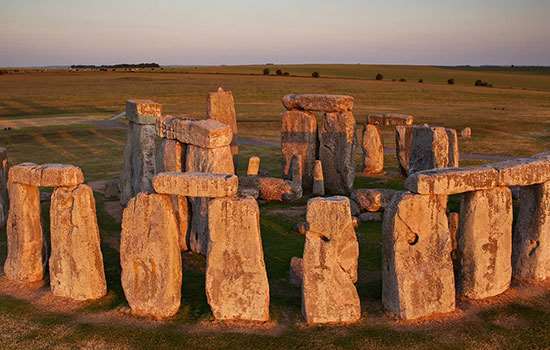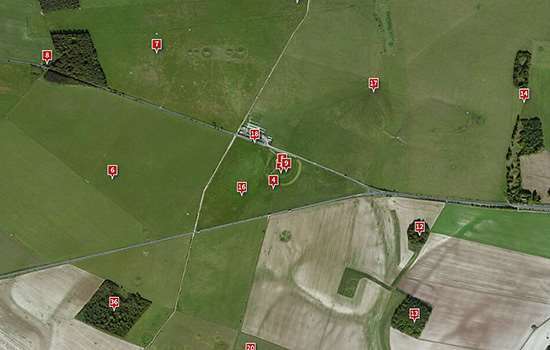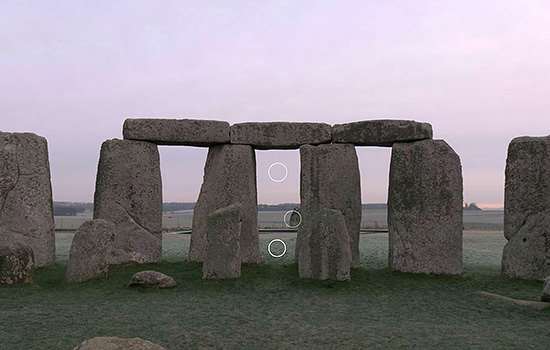The Military and Salisbury Plain
Stonehenge and Salisbury Plain have long been linked with both the military and aviation, and the First World War aerodrome wasn’t the first military establishment – or the first flying ground – near the stones. In 1897, after the British Army had been carrying out training exercises on Salisbury Plain for some time, the War Office began buying up large areas of farmland to the north of Stonehenge, drawn by the area’s relative isolation.
The area also had a history of military ballooning – Royal Engineers reconnaissance balloons were taking part in exercises in the area from the 1880s. One happy result of these exercises is that the earliest known aerial photographs of any archaeological monument in Britain were taken of Stonehenge, by Royal Engineers balloonists, in the summer of 1906.
Aeroplanes first came to the area in 1909, when the civilian pioneer Horatio Barber rented a strip of land on nearby Durrington Down (which would become known as Larkhill), built a shed to house his plane, and made several test flights. A year later the first military aircraft sheds (hangars) were built there.
Initially the British government was slow to recognise that aeroplanes might be of any military use other than for reconnaissance. But when in 1911 they decided to expand the old Balloon Section of the Royal Engineers into an air battalion, they based its No. 2 Company – which was focused on planes – at Larkhill. In 1912 the company became part of the newly formed Royal Flying Corps (the air arm of the British Army). Military flying continued at Larkhill until the summer of 1914.
Why was Stonehenge Aerodrome built?
At the outbreak of war in 1914, the Royal Flying Corps (RFC) had no bomber aircraft in service. In summer 1917, however, heavy German bombing raids on Britain – particularly a daylight raid on London in June, which killed 162 people and injured many more – prompted a major re-evaluation of Britain’s air strategy and defence. As part of this the government decided to greatly increase the number of planes (mostly bombers) in service. More planes meant that more airfields were urgently needed, as well as training for those who were to fly them.
Stonehenge was one of many new airfields created across southern England as a result. Building of the 360-acre airfield began late in 1917, and it officially opened in November. Initially it was an RFC training site, but from January 1918 it became the No. 1 School of Aerial Navigation and Bomb Dropping. The Royal Naval Air Service (RNAS) Handley Page bombers arrived here in January 1918, in advance of plans for the newly created RAF – formed from the RFC and RNAS – to take over heavy bombing.
The No. 1 School (which soon dropped ‘Aerial’ from its name) stayed at Stonehenge until September 1919.
The Aerodrome and its buildings
Why site an aerodrome here? There were several good reasons – there was a fairly level expanse of flat, open land to use for landing and take-off, there were already military facilities nearby at Larkhill, and there was good road access. The nearness of Stonehenge itself seems to have been of little if any concern – after all, there was already a history of flying nearby.
The aerodrome had two camps, which lay on either side of a take-off and landing ground. The Main (or Day) Camp, only about 300 metres west of Stonehenge, straddled the London to Exeter road (now the A303) and contained the main technical buildings, offices and accommodation blocks. The Night Camp, which included two ‘permanent’ hangars to house the massive Handley Page bombers, lay to the north-west, close to what is now the Fargo Plantation drop-off point between the visitor centre and the stones.
As its name suggests, the Night Camp was intended for those who did their flying mostly after dark, but as it was incomplete by the time the Armistice was signed in November 1918, in practice the Main Camp probably served both night and day pilots.
Training at Stonehenge
The main role of No. 1 School at Stonehenge was to provide a final stage of training for pilots and observers before they were sent to the Western Front. Courses lasted about a month and the aim was to train up to 60 day bombing and 60 night bombing pilots a month, and the same number of observers.
The comprehensive syllabus included navigation, formation flying, cloud flying and bomb-dropping. Perhaps the strangest test was one designed to test a pilot’s ability to fly in a straight line. It was called ‘Head in Bag’, because the observer had to cover the pilot’s head:
Pilot’s head to be enclosed for not less than 9 minutes on each course. Observer to hand in a fair copy of graph showing Pilot’s course … Pilot must not deviate more than 15° off his course at any one time.
Pilot training was crucial at a time when 80% of flying casualties were caused not by enemy activity, but by the hazardous nature of flying itself. Its dangers are highlighted by an accident that trainee RNAS pilot Leslie Semple witnessed at Stonehenge in June 1918:
Today about 2pm saw a fellow spin into the ground on a DH9. Called up the ambulance and with another fellow ran with a fire extinguisher. On arrival found the pilot lying in a terrible condition … and still conscious. He was in terrible pain and asked to die. Gave address of his people etc. etc. Died about 4pm.
Aerodrome Life
Diaries and reminiscences provide an insight into life at Stonehenge aerodrome, and suggest that it wasn’t particularly well thought of by the trainees. Leslie Semple described the state of the airfield:
I was landing when my left wheel hit a large mound in the rough ground, instantly smashing one centre section strut and also swinging me around 90 degrees. This made me cut across the track of Lt. Bowie, who was landing directly behind me, with the result that he had to stall and … smashed two struts and a tyre … The airfield is in a rotten state and I have only had one crash previous to this in the whole of my flying career.
Another trainee, Cyril Box, was unimpressed by the camp, the planes and the instructors:
As a home … [the camp] was awful … The instructors were what we called ‘a windy lot’ too. It may have been the rather doubtful machines or it may have been that, being qualified and fairly experienced pilots ourselves, we were apt to draw comparisons. Whatever it was, nobody liked Stonehenge [camp] and everybody was glad that the course was a short one. Our whole object in life … was to get away again, although it was the last school and meant that the next place would be France.
After the war
The aerodrome had a very brief life – from building to closure, it only lasted four years. At the end of the war there were increasing calls to close it, although initially the Chief of Air Staff, Hugh Trenchard, pressed for it to have a role as part of his plans for a permanent air force. However, by early 1921 the aircraft that had been stationed there had all left, and concerns about the military presence and possible damage to the stones prevailed. The aerodrome closed later that year and the site was returned to its pre-requisition owner.
For a while the buildings were put to various uses – part of the aerodrome served as a pig farm and some buildings were used as temporary housing. But it was not long before the presence of the unsightly hangars and accommodation blocks prompted demands to ‘restore’ the landscape around Stonehenge – not just to what it had been before the war, but to a setting more in keeping with the monument.
In 1927 the Stonehenge Protection Committee was set up. Following a public appeal the aerodrome and neighbouring farmland were bought, and the land was handed to the National Trust. By the early 1930s the aerodrome’s buildings had all been dismantled and removed.
The Stonehenge landscape in 1928 (left), showing the few remaining buildings of the aerodrome (top), and a similar view in 2015. (Images © Historic England Archive)
The aerodrome and the Stonehenge landscape
Today, only earthwork lumps and bumps survive to remind us of Stonehenge’s First World War airfield. But though its physical remains are slight, its influence has proved much more enduring.
It was the airfield’s very existence that triggered debate for the first time about whether Stonehenge should be ‘restored’ to a more appropriate setting, and about what modern ‘intrusions’ in the landscape were and weren’t acceptable – a debate that continues today. The removal of the airfield itself as a result was just the first stage in a long process that would transform the monument’s setting. It was only in the late 20th century that the arable land nearest to Stonehenge was converted to pasture.
The belief that Stonehenge’s impact, in the eloquent words of a 1936 Office of Works official, was ‘lost and the spell broken unless it stands in solitary grandeur dominating the bare plain’, has been at the heart of efforts to manage its surroundings ever since. Stonehenge aerodrome’s fleeting history may only represent a tiny dot on the timeline of the monument whose name it shared, but it played a critical role in the process of transforming the Stonehenge landscape.
Stonehenge in the 20th and 21st CenturiesMythbuster: a Plot to demolish Stonehenge?
The idea that a working military airfield could have been sited so close to Stonehenge seems extraordinary now. Perhaps this is one reason why a story took hold – which is still repeated today – that the RAF wanted Stonehenge demolished because the stones were a hazard to flying. But was there any truth in it?
The story seems to have first appeared in print in 1956 in the book Stonehenge by Professor Richard Atkinson, published while he was excavating there. He wrote:
It is said that the authorities concerned demanded, in all seriousness, that the monument should be demolished, as its stones constituted a dangerous hazard to low-flying aircraft.
The story has since been repeated many times, both in archaeological literature and military history, always with slight variants, and either as fact or as rumour. But the different versions have one thing in common – not one of them cites an original source.
The story has recently been examined by Martyn Barber of Historic England. His comprehensive research into the aerodrome’s history uncovered nothing in any files to suggest that an official request to knock down Stonehenge was ever made. In fact, on the contrary, the records reveal that the military co-operated fully with the Society of Antiquaries, who maintained a map of all the archaeological sites in the area to make sure their locations were known.
Perhaps the story has been accepted without serious question for so long because it fitted the narrative that the Stonehenge landscape, and Stonehenge itself, have always been under threat from modern intrusions.
Find out more
You can find out much more about the aerodrome and the Stonehenge landscape from:
Martyn Barber, Stonehenge Aerodrome and the Stonehenge Landscape (Historic England, 2014)
Martyn Barber, ‘Restoring’ Stonehenge 1881–1939 (Historic England, 2014)
Timothy C Brown, Flying with the Larks: The Early Pioneers of Larkhill (Stroud, 2013)
Rob Langham, Bloody Paralyser: The Giant Handley Page Bombers of the First World War (Stroud, 2016)
Clive Semple, Diary of a Night Bomber Pilot in World War I (Stroud, 2008)
‘A Well Kept Secret … the WWI Airfield Sitting beside Stonehenge’ (Barrows, Biplanes & Bombers Facebook post, 19 March 2016)
Top image: Stonehenge aerodrome being built in 1917–18 (© National Museum of the Royal Navy)
-

History of Stonehenge
Read a full history of one of the world’s most famous prehistoric monuments, from its origins about 5,000 years ago to the 21st century.
-

Image Gallery: Soldiers at Stonehenge
This image gallery explores the story of how the landscape around Stonehenge and its communities were changed by the First World War.
-

The Stonehenge World Heritage Site Landscape
Explore this interactive map created by Historic England to find out about the latest in-depth research into the Stonehenge World Heritage Site landscape.
-

Virtual Tour of Stonehenge
Take an interactive tour of Stonehenge with this 360 degree view from inside the stones, which explores the monument’s key features.
